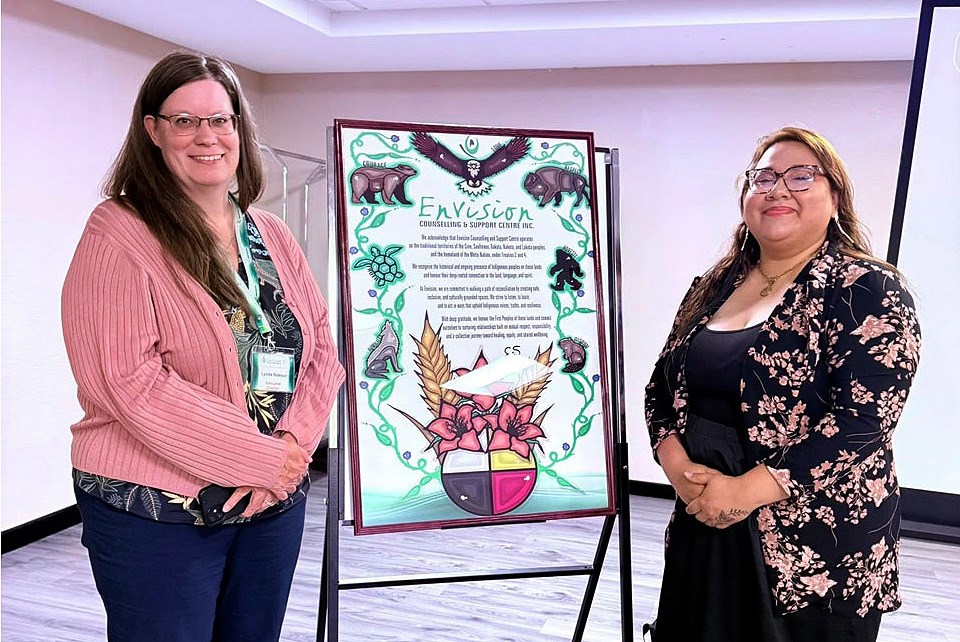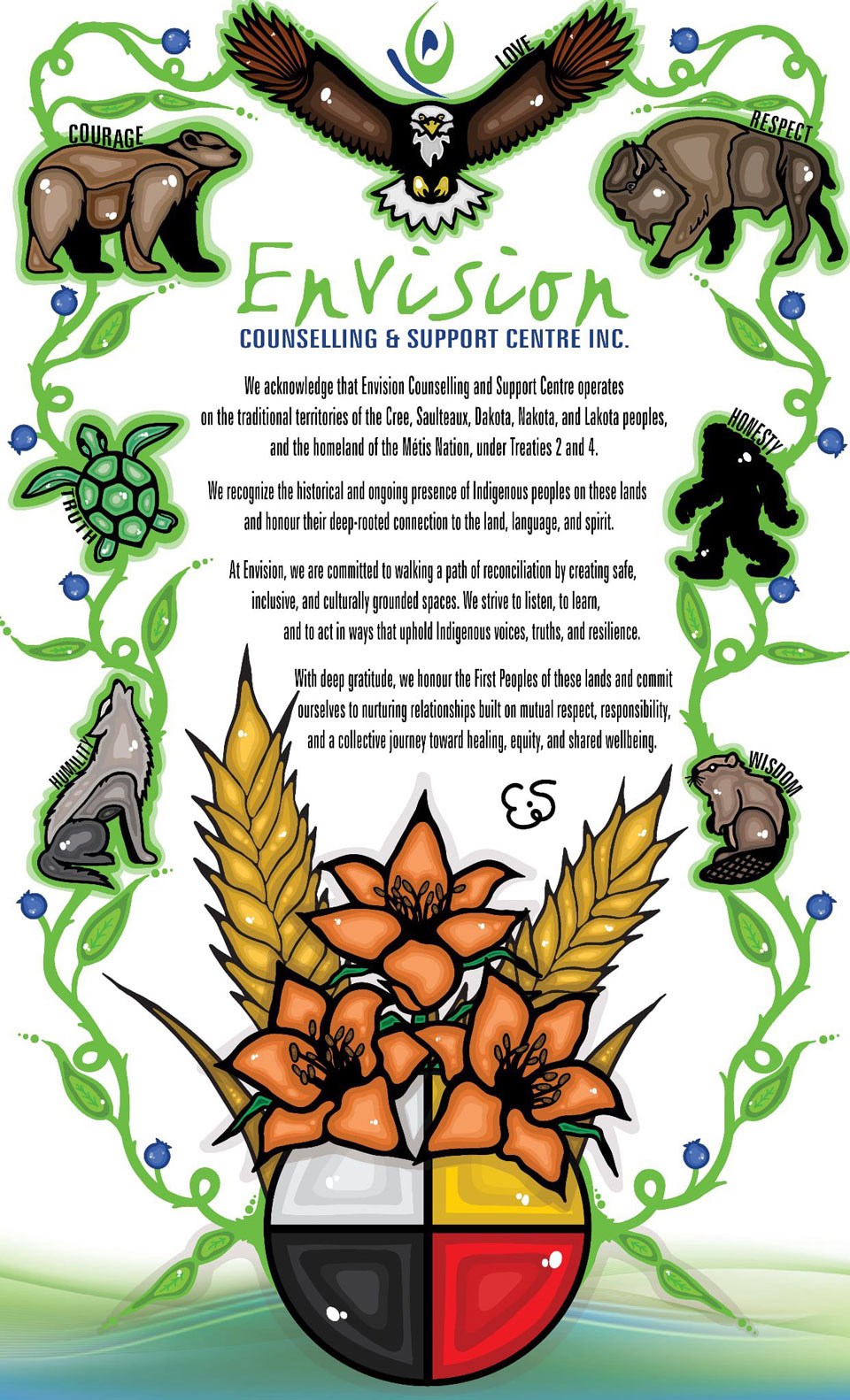SOUTHEAST SASKATCHEWAN — Emilee Steffensen, a self-taught digital and traditional artist from White Bear First Nation and the owner of Moonemis Cree-ations, has recently been commissioned by Envision Counselling & Support Centre Inc. to make a visual land acknowledgment for their offices.
“My passion for art was passed down through my family,” said Steffensen. “My Grandma Dale Boutin inspired me to draw and paint when I was young, and when she passed, I lost that spark for a while. Later in life, when my Kookum Shirley Sparvier, adopted me as her own, came into my life and started teaching me cultural knowledge, I reconnected with my art in a new way through my identity as an Indigenous woman.”
“Art became not only healing for me but also a way to reclaim and share culture, teachings, and stories. One of the things I’ve come to specialize in is visual land acknowledgments. I’ve created several now, and it’s something I take great pride and passion in. Each one is a reflection of both cultural teachings and community connection,” continued Steffensen.
Envision Counselling & Support Centre Inc. contacted Steffensen about doing a visual land acknowledgment.
“I have worked with them in the past by selling my artwork that they have hung up in their locations,” said Steffensen. “Lynda Rideout had seen my visual land acknowledgements through others that I have done and wanted one, something that represented Indigenous teachings and values while being unique to our shared Treaty Four and Two territory and what they do for the community. It was a respectful and collaborative approach, and from the very beginning, they trusted me to bring my voice and vision into the piece.”
Steffensen says she said yes because visual land acknowledgments are a powerful step beyond just words.
“They create lasting impact and visibility. Growing up, I didn’t see a lot of Indigenous representation in certain spaces, especially in professional or service-oriented organizations. So, to be asked to create something that permanently reflects Indigenous presence, teachings, and truth was meaningful,” said Steffensen.
“I’ve made it a part of my work to bring Indigenous visibility into public spaces, and this type of work is something I’ve found I truly excel at. It’s more than just art, it’s storytelling, education, and healing combined,” continued Steffensen.
Steffensen says she decided to make the Seven Grandfather Teachings the core of the visual land acknowledgement.
“The Seven Grandfather Teachings: Love, Respect, Bravery, Truth, Honesty, Humility, and Wisdom, are foundational teachings in many Indigenous communities, including mine. I chose to include them because they represent a way of life, a moral compass that guides how we treat each other and the land,” said Steffensen.
“I placed them in a circular form around the medicine wheel because they are interconnected, and like the wheel itself, they reflect balance, direction, and the cycles of life,” continued Steffensen. “It was important to ground the piece in teachings that speak to both Indigenous identity and shared human values.”
Steffensen then put Prairie Lilies and wheat around the Seven Grandfather Teachings.
“Prairie Lilies are Saskatchewan’s provincial flower (my grandmother Dale also loved Prairie lilies so, I’ve been adding them to all of my land acknowledgement, to honour her) and wheat is a symbol of the prairie landscape,” said Steffensen. “Including them was my way of honouring the land we share, Treaty 4 territory, and bringing visual harmony between Indigenous knowledge and the natural beauty of the area.”
“These elements also represent growth and resilience,” continued Steffensen. “I placed them around the teachings to show that cultural teachings can root and blossom within the land we live on, and that reconciliation can grow from that same soil.”
All of this then branches off the medicine wheel, which is a sacred symbol that represents balance, harmony, and the interconnection of all things: mind, body, spirit, and emotions.
“Everything in the piece branches out from the wheel because all aspects of life and teachings begin there,” said Steffensen. “The wheel is not just a symbol, it’s a way of understanding life. By allowing everything—flowers, teachings, symbols—to grow outward from the wheel, I wanted to show how our worldview is expansive and deeply rooted, and how we carry those teachings into everything we do.”
From initial concept to final touches, this piece took Steffensen roughly four weeks.
“I spent a lot of time reflecting. I didn’t want to just create something beautiful; I wanted every element to have purpose. Once I started designing, it evolved naturally,” said Steffensen. “I kept revisiting it until it felt like it told the story it needed to tell. The final moment, when I looked at it and felt peace, was powerful. That’s when I knew it was complete.”
Lynda Rideout, the executive director of Envision, ordered enough for every location: Estevan; Weyburn; Carlyle; Oxbow.
“I just want to say how grateful I am to have had this opportunity. It’s not just a project, it’s a statement of presence, of truth, and of healing,” said Steffensen. “To see Indigenous teachings and symbols displayed in a space like Envision is a step forward. I hope this piece starts conversations, encourages learning, and reminds people that reconciliation is ongoing, and it requires visible action, not just words.”





